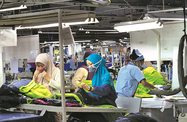Automotive sales are set to accelerate in Malaysia this year with increased investment in production and greater emphasis on fuel-efficient vehicles, though a number of adverse factors such as a new goods and services tax (GST) as well as the strengthening US dollar may weigh on demand.
In 2014, the total industry volume (TIV) rose 1.5% year-on-year with 665,675 units rolling off the lots, compared to 655,793 vehicles in 2013. The market was led by domestic producer Perodua, with sales of 195,000 units, followed by fellow Malaysian brand Proton with 115,000. Toyota was the best performer of the foreign manufacturers with 102,000 vehicles sold last year. The rate at which auto sales increased was well off the pace set by the rest of the economy, which rose by as much as 5.8% according to some estimates.
The Malaysia Automotive Institute (MAI) has predicted sales will hit the 700,000 mark in 2015, a 5.1% increase on the 2014 roll-out. The total could reach 750,000 if the government adopted a proposal by the state-backed agency to introduce a buy-back scheme to get older vehicles off the roads to stimulate demand, it added.
However, market research firm Frost & Sullivan predicts a more modest 3.15% increase in sales for 2015. Growth will be driven by demand for passengers cars, according to the report published in January, with sales estimated to rise 3.2% to 608,000 units. Demand for commercial vehicles is set to increase at a lower rate, possibly a reflection of a continued slowdown in the construction sector that curbed sales in 2014.
The small and compact car segment will lead growth according to Kavan Mukhtyar, a senior partner with Frost & Sullivan, due to factors such as fuel price volatility, the impending implementation of the GST and the cost of living. “Automotive spending is considered as discretionary and customers may buy the vehicle at one notch lower. Consumers would likely to move to fuel-efficient and compact segment,” Mukhtyar said, when presenting the outlook report.
EEV set to take a front seat
Fuel efficiency is set to take on greater importance in the Malaysian auto industry as the country aims to be a regional automotive hub of energy efficient vehicles (EEV). According to the latest MAI data, industry investment totalled RM8.9bn ($2.5bn) in the first nine months of 2014, with an increasing focus on EEV production, a target of the government’s National Automotive Policy (NAP) 2014.
The Frost & Sullivan report said manufacturers are looking for opportunities in the EEV segment to take advantage of government benefits and incentives in the sector. These include an automation capital allowance of up to 200% on the expenditure incurred within a specific period and a state fund to support research and development.
Demand for new vehicles, both in the private and commercial segments, will depend on a number of variables, one of which will be the overall health of the Malaysian economy.
In a note issued in January, Maybank Investment Bank Research was more bearish on the sector, noting that auto sales may be flat in the first half of 2015 or even contract marginally before rebounding in the latter part of the year. “Consumers will tighten their belts and adopt a wait-and-see approach as they brace for higher cost of living and uncertainties on car prices from the implementation of the GST in April,” the bank said.
Household demand for vehicles is also closely related to credit market conditions. Though historically monetary policy remains loose the banks have recently been encouraged to tighten up lending requirement as Malaysian households are close to their limits in terms of leverage.
While analysts agree the economy will advance this year, opinions on the rate of expansion varies. In January, Standard Chartered Global Research predicted Malaysia’s GDP to grow by 5.5% in 2015, marginally down on its estimates from 2014 of 5.8% due to the potential volatility caused by the implementation of the GST in April.
In addition, the oil price crash has hurt Malaysia − Asia’s only major oil exporter – providing reason, among other external factors, for the World Bank to be less optimistic in its forecast in mid-December. The bank estimates GDP growth at 4.7% for the coming year, down from an estimated 5.7% in 2014.
Dollar rise
Another factor that will continue to impact the auto sector in Malaysia is currency with the strengthening of the US dollar having a dual impact on the domestic industry. The ringgit lost around 10% against the dollar in 2014 and there is further downside risk for the coming year. A stronger greenback will push up the price of imported components, which represent up to 30% of input.
On the positive side for local producers, a stronger dollar means imported vehicles will be more costly, giving a price advantage to domestically made cars and commercial vehicles. The MAI has forecast that Proton and Perodua will raise their market share in 2015 to 52% from 46.8% last year.
The introduction of the 6% GST, set to come into effect on April 1 will also affect the car sector. Some in the industry have forecast automotive sales and prices could dip following the GST’s launch. Prices for new cars are generally expected to come down between 1-3% after the implementation of the GST, but the gains could be offset by the higher prices of imported auto parts.

